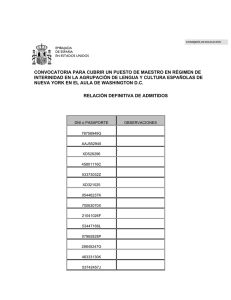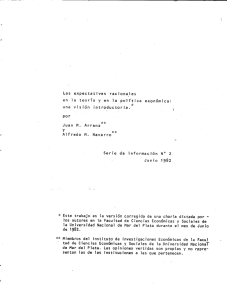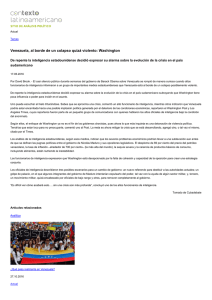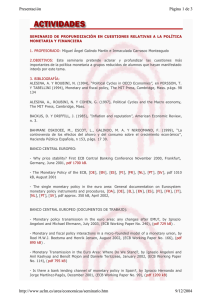Lecturas recomendadas - Centro de Estudios Monetarios
Anuncio
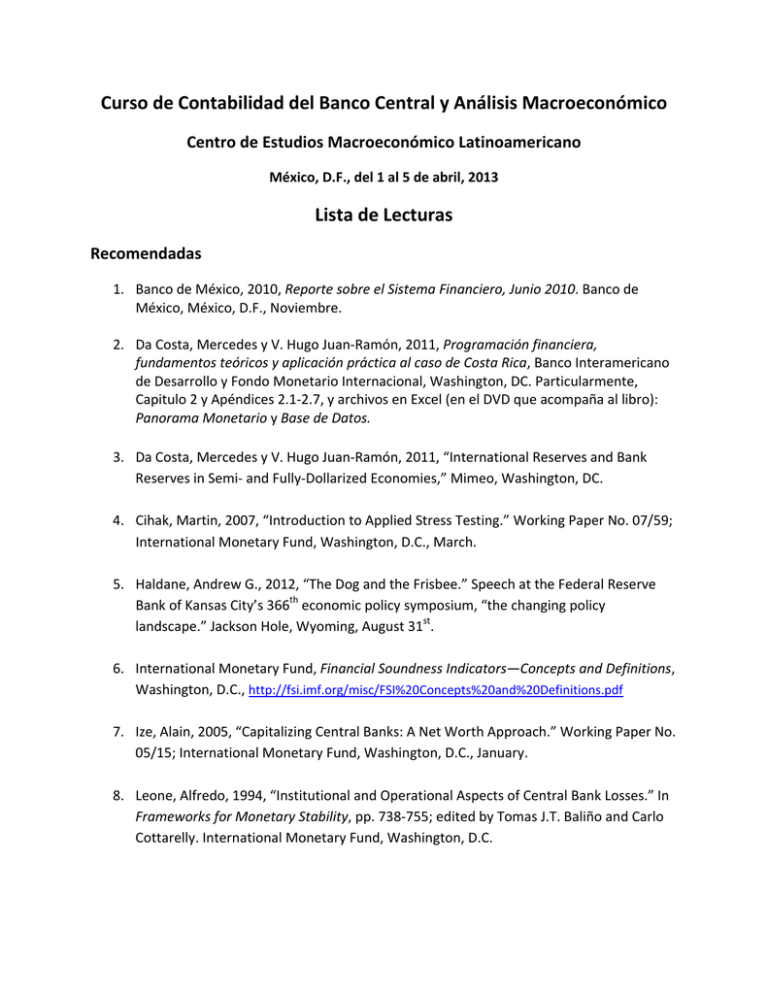
Curso de Contabilidad del Banco Central y Análisis Macroeconómico Centro de Estudios Macroeconómico Latinoamericano México, D.F., del 1 al 5 de abril, 2013 Lista de Lecturas Recomendadas 1. Banco de México, 2010, Reporte sobre el Sistema Financiero, Junio 2010. Banco de México, México, D.F., Noviembre. 2. Da Costa, Mercedes y V. Hugo Juan‐Ramón, 2011, Programación financiera, fundamentos teóricos y aplicación práctica al caso de Costa Rica, Banco Interamericano de Desarrollo y Fondo Monetario Internacional, Washington, DC. Particularmente, Capitulo 2 y Apéndices 2.1‐2.7, y archivos en Excel (en el DVD que acompaña al libro): Panorama Monetario y Base de Datos. 3. Da Costa, Mercedes y V. Hugo Juan‐Ramón, 2011, “International Reserves and Bank Reserves in Semi‐ and Fully‐Dollarized Economies,” Mimeo, Washington, DC. 4. Cihak, Martin, 2007, “Introduction to Applied Stress Testing.” Working Paper No. 07/59; International Monetary Fund, Washington, D.C., March. 5. Haldane, Andrew G., 2012, “The Dog and the Frisbee.” Speech at the Federal Reserve Bank of Kansas City’s 366th economic policy symposium, “the changing policy landscape.” Jackson Hole, Wyoming, August 31st. 6. International Monetary Fund, Financial Soundness Indicators—Concepts and Definitions, Washington, D.C., http://fsi.imf.org/misc/FSI%20Concepts%20and%20Definitions.pdf 7. Ize, Alain, 2005, “Capitalizing Central Banks: A Net Worth Approach.” Working Paper No. 05/15; International Monetary Fund, Washington, D.C., January. 8. Leone, Alfredo, 1994, “Institutional and Operational Aspects of Central Bank Losses.” In Frameworks for Monetary Stability, pp. 738‐755; edited by Tomas J.T. Baliño and Carlo Cottarelly. International Monetary Fund, Washington, D.C. 9. Oliver Oliver Jeanne and Romain Ranciere, 2006, “The Optimal Level of International Reserves for Emerging Market Countries: Formulas and Applications.” Working Paper No. 06/229; International Monetary Fund, Washington, D.C., October. 10. Stella, Peter and Ake Lonnberg, 2008, “Issues in Central Bank Finance and Independence.” Working Paper No. 08/37; International Monetary Fund, Washington, D.C., February. 11. Superintendencia General de Entidades Financieras (SUGEF) de Costa Rica, Dirección General de Supervisión, “Modelo de Calificación según Acuerdo SUGEF 24‐00,” http://www.sugef.fi.cr/pagina.asp?lang=0&pagina=servicios/entidades/default.asp?Padre=3 Sugeridas 1. Adler, Gustavo, Pedro Castro, Tovar Mora and Ernesto Camilo, 2012, “Does Central Bank Capital Matter for Monetary Policy?” Working Paper No. 12/60; International Monetary Fund, Washington, D.C., February. 2. Adler, Gustavo and Camilo E. Tovar, 2011, “Foreign Exchange Intervention: A Shield against Appreciation Winds? Working Paper No. 11/165; International Monetary Fund, Washington, D.C., July. 3. Aizenman, Joshua, Menzi D. Chinn, and Hiro Ito, 2008, “Assessing the Emerging Global Financial Arquitecture: Measuring the Trilemma’s Configuration over Time.” National Bureau of Economic Research, NBER, Working Paper 14533, Cambridge, MA, December. 4. Bank for International Settlements, 2010, “Assessing the macroeconomic impact of the transition to stronger capital and liquidity requirements,” Interim Report of the Macroeconomic Assessment Group established by the Financial Stability Board and the Basel Committee on Banking Supervision. August. CH‐4002 Basel, Switzerland. http://www.bis.org/publ/othp10.pdf 5. Basel III Handbook, December 8, 2011, disponible en la página web de Accenture, http://www.accenture.com/SiteCollectionDocuments/PDF/Accenture‐Basel‐III‐Handbook.pdf 6. Calvo, Gullermo, Alejandro Izquierdo, and Rudy Loo‐Kung, 2012, “Optimal Holdings of International Reserves, With Special Reference to Balance‐Sheet Effects and Sudden Stop.” Mimeo, Washington, D.C., May 18, 2012. 7. Corporación Andina de Fomento (CAF), 2011, Servicios Financieros para el Desarrollo: Promoviendo el Acceso en América Latina. Serie: Reporte de Economía y Desarrollo. http://www.caf.com/attach/19/default/RED2011.pdf 8. Dewatripont, Mathias and Jean Tirole, 1994, The Prudential Regulation of Banks, The Walras‐Pareto Lectures, The MIT Press, Cambridge, Massachusetts. Particularmente, Capitulos 2 y 3. 9. Federal Reserve System, Factors Affecting Reserve Balances, H.4.1 releases (various dates). Washington, D.C. http://www.federalreserve.gov/releases/h41/ 10. Federal Reserve System, 2012, “Transcript of Chairman Bernanke’s Press Conference” of December 12, 2012. Washington, D.C. http://www.federalreserve.gov/mediacenter/files/FOMCpresconf20121212.pdf 11. Guimaraes Roberto F. and Cem Karacadag, 2004, “The Empirics of Foreign Exchange Intervention in Emerging Market Countries: The Cases of Mexico and Turkey.” Working Paper No. 04/123; International Monetary Fund, Washington, D.C., July. 12. Inter‐American Development Bank, 1996, Banking Crises in Latin America, Part VI “Lessons from Country Experiences” (Mexico, Argentina, Chile, Venezuela, United States). Edited by Ricardo Hausmann and Liliana Rojas‐Suarez. Published by the Inter‐ American Development Bank, Distributed by the Johns Hopkins University Press. 13. International Monetary Fund, 2006, Financial Soundness Indicators, Compilation Guide, Washington, D.C. Particularmente Apéndices II, III y V. http://www.imf.org/external/pubs/ft/fsi/guide/2006/pdf 14. International Monetary Fund, 2000, Manual de Estadísticas Monetarias y Financieras, Washington, D.C. http://www.imf.org/external/pubs/ft/dp/2009/dp0902.pdf 15. International Monetary Fund, 2008, Monetary and Financial Statistics: Compilation Guide, Washington, D.C. http://www.imf.org/external/pubs/ft/dp/2009/dp0902.pdf 16. Jones, Matthew T., Paul Hilbers, and Graham Slack, 2004, “Stress Testing Financial Systems: What to Do When the Governor Calls.” Working Paper No. 04/127; International Monetary Fund, Washington, D.C., July. 17. Juan‐Ramon, V. Hugo, Ruby Randall, and Oral Williams, 2001, “A Statistical Analysis of Banking Performance in the Eastern Caribbean Currency Union in the 1990s.” Working Paper No. 01/105; International Monetary Fund, Washington, D.C., August. 18. Levy Yeyati, Eduardo, 2006, “The Cost of Reserves.” Centro de Investigación en Finanzas (CIF), Universidad Torcuato Di Tella, Documento de Trabajo 10/2006. 19. Neely, Christopher J., 1998, “Technical Analysis and the Profitability of U.S. Foreign Exchange Intervention,” Review, Federal Reserve Bank of St. Louis, July/August. 20. O’Dogherty, Pascual, 1997, “La Instrumentación de la Política Monetaria por el Banco Central,” en La Política Monetaria en México, Suplemento, Gaceta de Economía, Año 3, Numero 5, ITAM, México, D.F. 21. Restrepo, Jorge, Luis Salomo, and Rodrigo Valdés, 2009, “Macroeconomía, Política Monetaria y Patrimonio del Banco Central de Chile,” Economía Chilena, Volumen 12‐No. 1/abril. 22. Slovik, Patrik and Boris Cournede, 2011, “Macroeconomic Impact of Basel III,” OECD Economic Department Working Papers, No. 844; OECD Publishing. http://dx.doi.org/10.1787/5kghwnhkkjs8‐en. 23. Stella, Peter, 1997, “Do Central Banks Need Capital?” Working Paper No. 97/83; International Monetary Fund, Washington, D.C., July.
